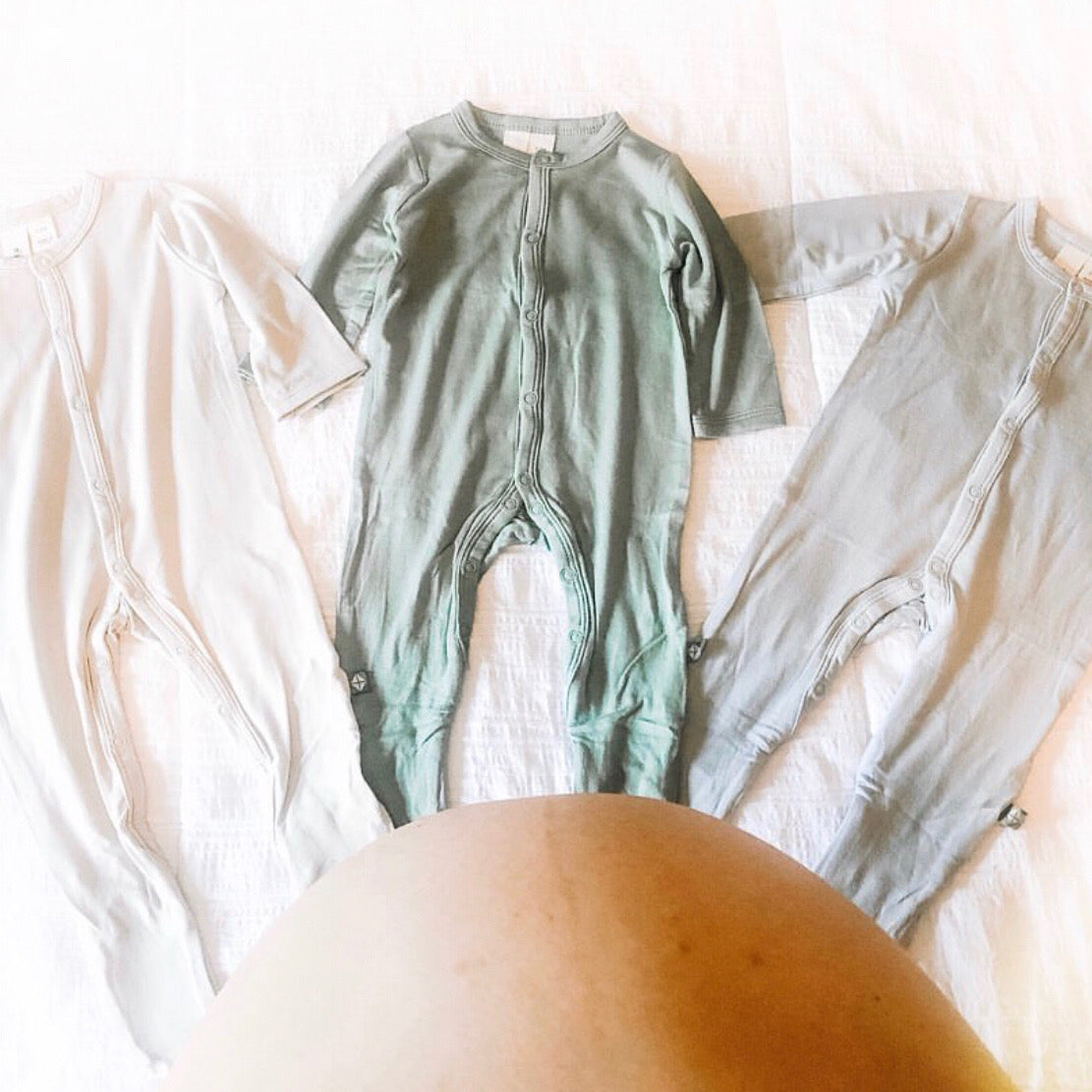If you haven’t heard of a dream feed before, you may be asking yourself “what is a dream feed” exactly?! This term was coined by The Baby Whisperer to describe a feeding you perform in the late evening hours while your baby is asleep. You simply rouse them gently enough that they take in a feeding before you go to bed, in order to improve their night sleep. Babies will instinctually take in what they need during that feeding (either by breast or bottle).
If you have been wondering if a dream feeding is the answer to your infant’s night wakings, then this blog will cover all the information you need to try it out! Some frequently asked questions we will cover are:
- Why should you dream feed your baby?
- How to dream feed
- What ages are best for dream feeding infants?
- When to stop the infant dream feed
- Is dream feeding safe?
- Infant dream feed schedule
- Should you burp baby after dream feeding?
- How much do you feed during a dream feeding?
- Infant dream feed pros and cons
- How to wake a baby for the dream feed
- How to drop the dream feed
Why Should You Dream Feed Your Baby?
Why would a dream feed work (or what is the theory behind it)? If your baby typically does a bedtime feeding around 7pm, then they may wake at 11pm, 12am, 1am to eat again. That means you may have only been asleep for an hour or 2 yourself!
By giving a feeding in the 10pm (or so) hour, you eliminate the waking out of true hunger and may allow baby to sleep longer (and you too)! In other words, it resets their feeding clock back to zero. This essentially elongates the baby’s long stretch of sleep to align with parents so they are getting more sleep. We are filling their tummy up before they have the chance to get hungry and wake you up in the middle of the night.
Using Dream Feeding Temporarily
A dream feed can also be useful to temporarily implement when you begin sleep training. This way baby does not associate waking and crying with being fed. You can feed while they are asleep and comfort/soothe when they are awake. Some may even consider this a tear-free way to night wean a little one.
Dream Feeding Throughout the Night
Another way the term “dream feed” is used, is by bedsharing+breastfeeding moms. Most of the time a baby will only rouse a little bit, nurse, and fall back to sleep without waking and crying. Essentially they are eating in their sleep or very light sleep cycles.
You may find that the idea of the dream feed is more well known and popular than the actual results of the dream feed. It may be the equivalent of an Urban Myth.
How to Dream Feed
Ideally, we want the baby to stay asleep or doze during the dream feeding. Follow these steps to dream feed your little one:
- Step one: Gently rouse your little one just enough that they latch onto the bottle or breast. They need to alert enough to eat, but not so much that they wake up and are cranky. That could throw off the whole night! Some babies are roused enough just by taking them out of their sleeping space, others may need a little more! Pro tip: The best way to rouse them is to initiate the rooting reflex by stroking their cheek.
- Step two: Feed the baby! Simple, right? Make sure their head is slightly elevated. If you’re having trouble getting them to latch, then they are not awake enough. Get comfortable and let baby eat until full.
- Do not give up! It may not work the first few times. Try to give it a consistent effort for a week before deciding if it works for your family.
It is important to note that there is very little (or none) evidence based research to prove whether a dream feed is effective or not. It is mostly anecdotal information.
What Ages Are Best for Dream Feeding Infants?
There is a wide variance on what ages to dream feed. You can start a dream feed for your baby at any time or dream feed newborn.
Imagine you have a little one who is really fussy in the late evening hours. It's probably because of the witching hour baby time period. It's important to know what age does the witching hour stop and how to handle it. Parents often preemptively feed them during that phase and avoid having another lengthy waking from a fussy baby.
You can definitely introduce this concept at any age, however as a professional, I find it works best (if it is going to work) prior to 3-4 months of age when they already have multiple night feedings.
When To Stop the Infant Dream Feed
It typically works best to try to wean the dream feeding before 6-9 months of age. After that, it can disrupt sleep even more than it helps. Babies tend to become a lot more alert by that age and will fully wake up, wanting to play when you are trying to sneak in that extra feeding!
If you find that your little one is having a difficult time settling after you have done the dream feed, then that is usually a sign to stop the dream feed. It is important to remember that this is a short term solution to night wakings and will eventually become a habit.
Some pediatricians will agree that babies do not need feedings in the night after 6 months of age, but every baby is different. so it's important to know when babies start to sleep through the night. Since a dream feed is typically done to get a little one sleeping through the night, it is definitely best to check in with your pediatrician!
Is Dream Feeding Safe?
Dream feeding is totally safe, when you feed just like you would during the day! It is not safe if you prop a bottle or feed the baby while they are lying flat as this is a choking hazard.
You also want to make sure you are alert while feeding your little one so that you do not risk falling asleep holding them while on an unsafe surface (like a recliner) or dropping them should you doze off. We always recommend following safe sleep practices.
Infant Dream Feed Schedule

A dream feeding schedule would look something like:
- 6 or 7pm bedtime feeding
- 10 or 11pm dream feeding
- 3, 4, 5am night feeding (and this waking gets later and later as baby grows, develops their long stretch of sleep, and eventually sleeps through until their normal morning wake up!)
- Without the dream feeding, it may look something like:
- 6 or 7pm bedtime feeding
- 12am night feeding
- 4am night feeding
Which means you are waking twice, instead of just once further fragmenting your night sleep as well as theirs.
Should You Burp Baby After Dream Feeding?
Absolutely! Burping is typically easier during the night when they are more relaxed. You will want to do this to avoid any discomfort waking your baby soon after you put them down. This can also help to avoid them spitting up after the dream feeding.
It is helpful to hold them upright for 10 or so minutes after the feeding to allow them time to digest, get the air out and relax back into a deeper sleep when you put them back down. Some babies naturally take in less air during the dream feed because they are more relaxed. In this case, they may not burp but you should still try to get one out.
How Much Do You Feed During a Dream Feeding?
There is no right or wrong answer to this one; you can do a small “snack” feeding of 2-3oz, you could do their normal 4-6oz, you could feed on one side if breastfeeding, or feed on both sides! Some babies will only drink a tiny amount, some will take in the full feeding. You know your baby best, so you can experiment and see what works!
Infant Dream Feed Pros and Cons
Pros for the dream feeding:
- Extends their night sleep (and yours!)
- Babies sleep through with less disrupted sleep
- Their sleep is more aligned with yours
- May help a breastfeeding mom’s supply (or you could pump before you go to bed if you would rather and the dream feeding is not working!)
- It can lessen the amount of time your baby cries by anticipating their need for food
- Anticipates their need for food and takes the guesswork out of night wakings
- Sleepy babies are cranky babies, so by ensuring baby wakes less frequently at night, baby may be less cranky during the day
- For moms, knowing they may get a few extra hours of sleep instead of going to bed wondering when the next waking may be, will actually improve their sleep (even if it doesn’t actually work- kind of like a placebo effect)
- May help baby avoid any pain associated with reflux after a feeding
- If your little one is struggling with intake during the day, the night feed can get the extra calories in that they might have missed
Cons for the dream feeding:
- You may have to stay up later to get it in
- May not always work unfortunately (this means they may not sleep longer after it, or may wake more frequently because of it)
- May disrupt their sleep (they may not go back to sleep easily after eating at that time)
- Disrupts baby’s natural sleep cycle (and interrupts their most restorative sleep they will get during the night)
- Can be difficult to drop it (it becomes habitual when we condition them to eating at that time)
- Some will say this goes against “feeding on demand” and is forcing a meal on your little one they may not already want/need
- It reinforces that food equals sleep, enforcing the brain and tummy connection. It just blows past feeding cues from our little ones
- It can overfill a baby’s tummy and cause sleep disruption plus gastrointestinal discomfort
- According to care.com, “When baby becomes dependent on dream feeding, no learning is taking place, and it's possible that he'll lose his ability to suck purposely, says Potock. "My recommendation is to keep a balance between dream feeding and conscious suckling. That way, baby is soothed and comforted and may even fall asleep at the breast or toward the end of a bottle, but is still learning to suck-swallow-breathe with intention over time."
How To Wake a Baby for the Dream Feed
If your baby is having a hard time waking (just enough) to eat, then you can try a few different things:
- You can try at a different time of the night. If your baby is in a deep sleep cycle, then you can wait until you see them in a light sleep cycle to feed; they may be easier to rouse at that point!
- You can unswaddle them from the bottom and change their diaper (or use a Kyte BABY sleep bag which has a zipper at the bottom to make night time changes easier).
- Rub a wet cloth or wet wipe on their cheek.
- Tickle the bottom of their feet (annoying them just enough to get them to latch onto the bottle or breast).
- Try changing the position you are holding baby in (switch sides for example).
- Express some milk from the bottle or breast onto their lips; this may entice them to open their mouth enough to eat!
Pro tip: if you need light, use something soft, like a salt lamp. A salt lamp will not interrupt melatonin production which means you can go to sleep much easier after doing the dream feed.
“The great thing about babies is that they have a natural instinct to suck if they’re at a nipple,” says Jason Freedman, co-author of the book The Dream Feed Method.
Involving Your Partner in the Dream Feed
Remember, this is a great way for dad to help out! If you are formula feeding, you can take shifts and dad can give the dream feed so that mom can get in a nice long stretch of sleep in the beginning of the night.
If you are breastfeeding, you could consider introducing a bottle, pumping some milk before you go to bed and allowing dad to give the bottle for the dream feeding-- again, giving mom a great long stretch of sleep!
For newly postpartum moms, sleep is so important! If you feel like you could be suffering from postpartum depression or anxiety, then use this list from the National Sleep Foundation to check in with yourself and see if the dream feed helps you rest better!
How to Drop the Dream Feed

You will wait to drop the dream feeding until your baby is able to sleep from the dream feed to their normal morning wake up time, through any other night feedings. You may choose to keep the dream feeding at that point, or you may want to wean it.
Once they are sleeping from the dream feeding to the morning wake up and have dropped any night feedings or early morning feedings, you can try to wait about 2 weeks before dropping the dream feed.
When you are ready to drop the feeding, you have a lot of options!
- You could wean the amount of ounces you are feeding if you are bottle feeding (by ½ an ounce every second or third night; more if you are in a hurry)
- You could wean the amount of time you are feeding if you are breastfeeding (so you would want to take note of how long the dream feed takes and then you can cut it by 1-2 minutes every second or third night)
- You could also drop the feeding cold turkey and utilize baby sleep training method to address any night wakings
The dream feed method book suggests dream feeding a newborn at 1 and 4am (give or take), and gradually moving those feedings earlier until you are down to one feeding and moving that one earlier until you no longer need it.
They also boast this will get your baby sleeping through the night by 4 months. As a professional, I believe this is a little bit ambitious, but if it helps families get more sleep (even if it does not mean sleeping through the night completely without feedings) then I am all for it!
As always, address this with your healthcare provider as they are able to assess your child’s growth and overall health! It will also be easier to drop the dream feed if your child is already an independent sleeper at bedtime! Otherwise, when they wake up, they will need assistance getting back to sleep even if you are not feeding them.
Establish a Great Daytime Routine to Support Night Sleep
Another important factor when working to drop a dream feed is to make sure you have a great daytime routine. This is important because:
- This ensures they are getting an appropriate amount of sleep (so they are not waking because they are over or undertired at night)
- Their nutritional needs are met (getting in nice, full feedings during the day and they are not skipping feeds)
- Sets up their circadian rhythm/biological clock
- Meeting their needs before they meltdown
A helpful practice to put into place is to offer soothing at every waking as opposed to feeding at every waking. You can implement a sleep training method (like pick up put down) or offer a pacifier and see if that soothes them back to sleep.
Typically, you cannot soothe a hungry baby without a feeding! (No, this is not always the case so again, check in with your health care provider.)
"Le Pause" Before Waking
It is also helpful to practice “le pause” for any wakings. If you are not familiar with “le pause”, essentially, you stop, wait, and listen to what your child sounds like when they wake up.
If it is pretty mild fussing, grunting, etc and not full out crying, then you may be comfortable practicing that pause in order to let your little one settle back into their next sleep cycle. If they are truly upset and need intervention, then you can step in for reassurance!
The worst case scenario with dropping the dream feed is that they continue to wake for it. In that case, you may choose to add it back in for a short period of time and try again later.
Pro tip: while introducing a dream feed, consider sizing up in diapers, using night time diapers, or inserting diaper booster pads as the extra intake may cause them to leak out of their diaper.
Takeaways About the Infant Dream Feed
- Forget all the “rules.” There are no hard and fast rules. You can try it at 9pm, 10pm, 11pm.
- You can swaddle or unswaddle. You can change their diaper or leave them as undisturbed as possible.
- Do not panic if they wake up. Just keep the interactions low, lights down, and make it a relaxing feeding for you both.
- Try not to stress if you attempt the dream feed and it does not work! It may not work right away and it is up to you if you would like to continue trying it, or let your baby lead the way with night feedings.
- Either way is perfectly fine. Find what works for you and your baby! Do not get frustrated if it doesn’t work for your little one. There are a lot of other options out there to get you both better sleep!
- We all know that new babies come with a certain level of sleep deprivation, and a dream feed can be one way to combat that.
- There haven’t been any proper randomised, controlled studies into dream feeding so most of the pros and cons are based on anecdotal evidence and people’s opinions.
- It definitely does not hurt to try it!
- Best case, it buys you some extra hours of sleep and worse case, you wake at your normal feeding times.
Author Bio: Ashley Olson is a certified pediatric sleep consultant, owner of Heaven Sent Sleep, and passionate about helping new parents, experienced parents, desperate and sleep-deprived parents form healthy sleep habits for their children.
She has over 3 years of experience in working with families and has completed over 150 hours of coursework plus continuing education related to infant and toddler sleep. The focus of her work is on fostering a routine that grows your bond with your child while improving their sleep habits. She specializes in custom sleep plans and one on one support in changing sleep practices!


























